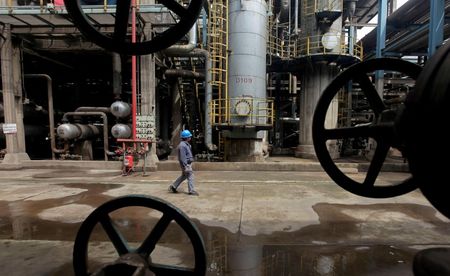Commodities
Oil prices fall despite raised Israel-Hezbollah tensions

Investing.com– Oil prices slipped lower Monday, with raised geopolitical tensions in the Middle East insufficient to overturn concerns of weakening global demand.
At 07:55 ET (11:55 GMT), fell 0.7% to $76.62 a barrel, while dropped 0.6% to $79.81 a barrel.
Golan Heights strike ramps up Middle East tensions
A rocket strike in the Israeli-occupied Golan Heights over the weekend reportedly killed at least 12 people, and has been blamed by both Israel and the U.S. on Iran-backed Hezbollah, who have denied responsibility for the attack.
Israel has vowed retaliation against Hezbollah in Lebanon, and Israeli jets hit targets in southern Lebanon on Sunday.
These increasing tensions saw traders attach a degree of risk premium to oil prices, especially in the event of a wider war between Israel and Hezbollah. Such a scenario could potentially disrupt crude supplies in the Middle East.
The news is also seen diminishing the prospect of a ceasefire between Israel and Hamas in Gaza, which had been gaining momentum.
China demand fears, supply worries keep oil on backfoot
However, the crude market has unable to retain earlier gains as the prospect of weaker demand and a potential supply glut in the coming months weighed on sentiment.
Persistent concerns over top importer China, as it grapples with a slowing economic recovery, continued to weigh on oil, after sparking steep losses in crude over the past three weeks.
The prospect of a supply glut in the coming months – amid increased oil production in the U.S. and other non-OPEC countries – has also weighed on oil prices in recent weeks.
The weakness in the market comes ahead of the OPEC+ Joint Ministerial Monitoring Committee meeting, which will be held on Thursday.
The committee is not expected to recommend any changes to output policy, but “if there are any surprises, they would likely come in the form of delaying the start of the gradual easing in supply cuts, which is set to start in October,” said analysts at ING, in a note.
Speculators turning negative
The weakness in the crude market of late have resulted in speculators turning increasingly negative.
The latest positioning data shows that speculators reduced their position in ICE by 37,541 lots over the last reporting week, leaving them with a net long of 146,349 lots as of last Tuesday. Speculators also cut their net long positions in NYMEX WTI by 24,312 lots to 239,237 lots.
“Concerns over Chinese demand have led to these speculative outflows,” analysts at ING said, in a note. “While this is not isolated to oil, metals have also seen heavy speculative selling recently on the back of China worries.”
(Ambar Warrick contributed to this article.)
Commodities
Oil prices rise; U.S. crude inventories plunge, Russia-Ukraine truce eyed
Commodities
India’s Reliance to stop buying Venezuelan oil over US tariffs, sources say
Commodities
Oil prices climb on Venezuela supply worries

 Forex3 years ago
Forex3 years agoForex Today: the dollar is gaining strength amid gloomy sentiment at the start of the Fed’s week

 Forex3 years ago
Forex3 years agoUnbiased review of Pocket Option broker

 Forex3 years ago
Forex3 years agoDollar to pound sterling exchange rate today: Pound plummeted to its lowest since 1985

 Forex3 years ago
Forex3 years agoHow is the Australian dollar doing today?

 Cryptocurrency3 years ago
Cryptocurrency3 years agoWhat happened in the crypto market – current events today

 World3 years ago
World3 years agoWhy are modern video games an art form?

 Commodities3 years ago
Commodities3 years agoCopper continues to fall in price on expectations of lower demand in China

 Economy3 years ago
Economy3 years agoCrude oil tankers double in price due to EU anti-Russian sanctions

























